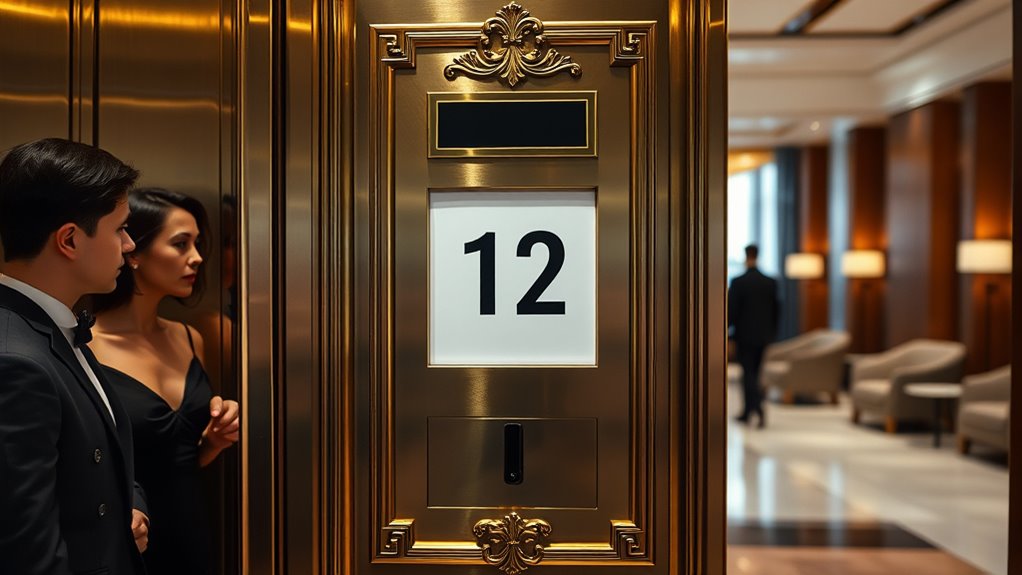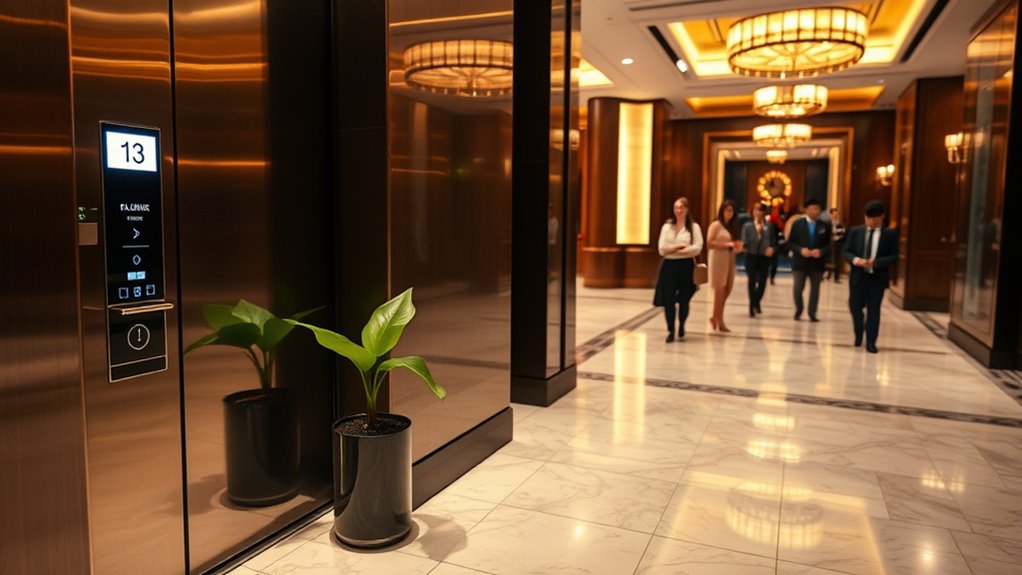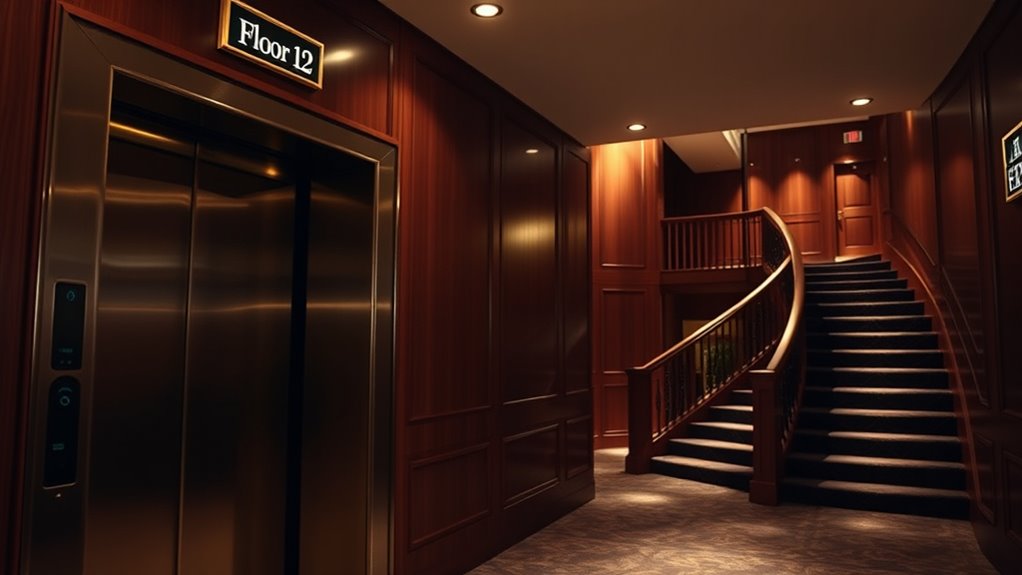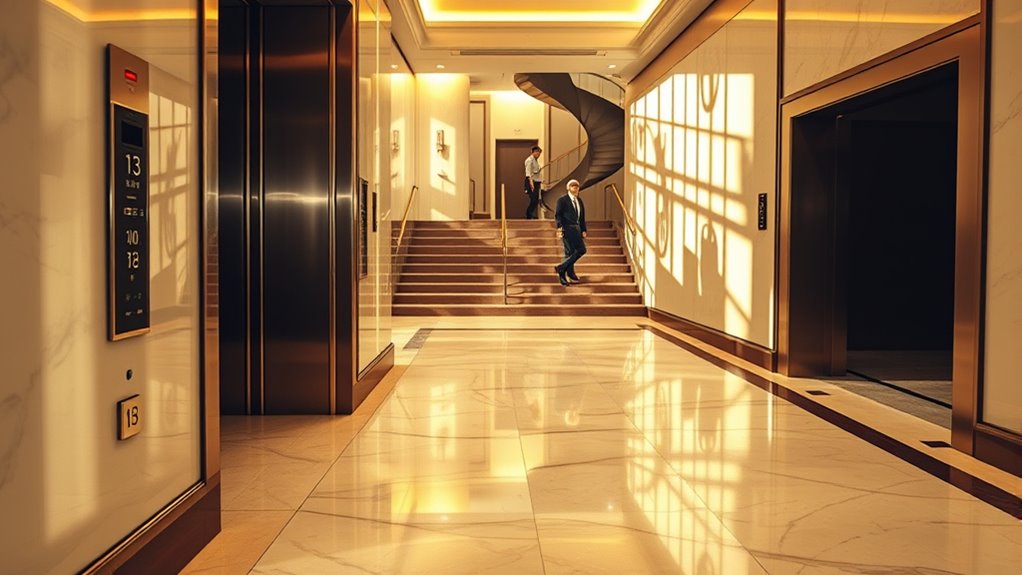You won’t find a 13th floor in many hotels because the number 13 is widely seen as unlucky, a superstition known as triskaidekaphobia. Hotels omit it to ease guest anxiety and respect cultural beliefs tied to bad luck. This careful design choice balances tradition with guest comfort, often replacing the 13th floor label with alternatives like 14 or 12A. If you’re curious about how these practices impact hospitality design and marketing, there’s more to uncover.
Origins of Triskaidekaphobia

Although you might not realize it, the aversion to the number 13—known as triskaidekaphobia—has deep historical roots that greatly influence hospitality design today. Understanding the triskaidekaphobia origins reveals how cultural beliefs and superstitions from ancient civilizations shaped this fear. The historical significance lies in how 13 has been associated with misfortune, stemming from myths and religious contexts that branded it as unlucky. As someone involved in hotel design or management, recognizing these origins helps you appreciate why omitting the 13th floor isn’t just superstition but a strategic decision to respect guest comfort and cultural sensitivities. This insight empowers you to balance tradition with innovation, creating spaces that feel welcoming while acknowledging the deep-seated anxieties tied to the number 13.
Historical Examples of the Number 13 in Architecture
When you explore architectural history, you’ll find that the number 13 has appeared in building designs despite its negative reputation. Several historical buildings incorporate the number 13 intentionally, reflecting its architectural significance beyond superstition. For instance, some Gothic cathedrals feature 13 pillars or windows, symbolizing completeness or religious narratives. In Renaissance architecture, the number 13 was sometimes used to create harmonic proportions, underscoring its role in design principles. These examples reveal that architects historically valued 13 for its structural and symbolic qualities. By recognizing this, you can appreciate how architectural significance transcends cultural fears, offering a richer understanding of historical buildings. This perspective encourages freedom from superstition when analyzing architectural heritage and design choices.
Cultural Beliefs Surrounding the Number 13

Thirteen carries a weight of cultural meanings that can directly influence design decisions in architecture and hospitality. You’ll notice that the number 13 often carries strong cultural symbolism, representing misfortune or bad luck in many Western societies. This number significance stems from historical and religious contexts, where 13 disrupts the orderly sequence of 12, a number associated with completeness and harmony. When you’re designing or managing a hotel, being aware of these cultural beliefs is essential because they affect guest perception and comfort. By omitting the 13th floor or renaming it, you respect these deep-rooted cultural attitudes while avoiding potential negative associations. Understanding the number 13’s cultural symbolism helps you create spaces that feel welcoming and aligned with your guests’ expectations.
Psychological Impact on Hotel Guests
Since guests often associate the number 13 with bad luck, seeing a 13th floor can create unease or discomfort during their stay. Hotels prioritize guest perceptions to guarantee psychological comfort, recognizing that even subtle anxieties can affect overall experience. By omitting the 13th floor, establishments proactively reduce potential stressors tied to superstition, fostering a more relaxed environment. This approach reflects an understanding of how environmental cues influence mental well-being and guest satisfaction. You want to feel at ease, free from distractions that might disrupt your stay. Hotels that address these psychological factors demonstrate a commitment to creating spaces where guests can fully unwind, reinforcing trust and loyalty. Ultimately, managing guest perceptions around the number 13 helps maintain a seamless, positive hospitality experience.
How Hotels Label Floors Without a 13th

To minimize guests’ discomfort tied to superstitions, hotels adopt specific floor numbering systems that skip the number 13 altogether. Instead of labeling a floor as the 13th, you’ll often see it designated as 12A, 14, or even M, which aligns with the 13th letter of the alphabet. This strategic floor labeling helps maintain a seamless guest experience while addressing common anxieties. By adjusting floor numbers, hotels subtly influence guest perceptions, reducing any negative associations without drawing attention to the omission. This approach balances operational clarity with psychological comfort, ensuring guests feel at ease traversing the property. As you engage with these spaces, you might not even notice the absence of a “13th floor,” reflecting how thoughtful floor labeling shapes your overall stay experience.
Differences in Numbering Practices Around the World
Although floor numbering conventions might seem straightforward, they actually vary considerably across different regions, reflecting cultural beliefs and local customs. When you navigate global hotels, you’ll notice that numbering systems aren’t universal. In many Western countries, the ground floor is labeled as “1,” but in parts of Europe and Asia, the ground floor is “0,” shifting all subsequent floors. Some East Asian countries omit the number “4” due to its phonetic similarity to “death,” influencing floor labels distinctly from Western practices. Understanding these global practices helps you appreciate how hospitality adapts to cultural sensitivities, ensuring guests feel comfortable and respected. So, when you encounter unfamiliar floor numbering, remember it’s a deliberate choice shaped by tradition and local norms rather than mere inconsistency.
Superstition vs. Marketing Strategies in Hospitality
While superstition plays a significant role in how hotels approach floor numbering, marketing strategies often drive the decision to omit certain numbers like the 13th floor. You’ll find that superstitious beliefs around the number 13 can influence guest perceptions, potentially impacting bookings and overall satisfaction. Hotels leverage marketing tactics to sidestep this risk, opting to rename or skip the 13th floor altogether. This approach isn’t just about tradition; it’s a calculated move to maintain a positive brand image and avoid alienating superstitious guests. As you navigate hospitality options, understanding this balance between superstition and marketing helps you appreciate the subtle strategies that shape your experience, giving you the freedom to choose accommodations that align with your preferences and comfort.
Cases Where Hotels Embrace the 13th Floor
You might find it surprising, but some hotels choose to keep the 13th floor, challenging traditional superstitions head-on. In various cultures, the number 13 carries different meanings, influencing how properties label their floors. These hotels often use the 13th floor as a unique marketing tool to attract guests seeking novelty or to make a bold statement within the hospitality market.
Hotels Defying Superstition
Even though the number 13 often triggers avoidance in hotel design, some properties challenge this norm by prominently featuring the 13th floor. When you explore these hotels, you’ll see how they confront the superstition impact head-on, embracing transparency and redefining guest experience. This approach can signal confidence and modernity, appealing to guests who reject irrational fears.
Here’s what you should know about hotels defying superstition:
- Explicitly label the 13th floor in elevators and directories
- Offer exclusive amenities or themed experiences on the 13th level
- Use bold, positive branding to neutralize negative associations
- Engage guests with storytelling that reframes the number 13
Cultural Variations in Floor Numbering
Because cultural attitudes toward the number 13 vary widely, some hotels openly embrace the 13th floor as part of their design and marketing strategy. When you encounter such hotels, you’ll notice their floor etiquette aligns with local architectural norms rather than superstition. In many cultures, 13 holds neutral or even positive connotations, allowing architects and hoteliers to maintain straightforward floor numbering without omission. This approach respects guests’ cultural perspectives, offering transparency and easing navigation. By adhering to established architectural norms, these hotels promote inclusivity, letting you experience a space free from arbitrary taboos. Understanding these variations helps you appreciate how floor etiquette adapts globally, reflecting diverse beliefs while maintaining professional standards in hospitality design and guest experience.
Unique Marketing Strategies
While many hotels sidestep the number 13 due to superstition, some properties leverage it as a distinctive marketing tool that sets them apart in a competitive market. Embracing the 13th floor can positively influence guest perception when integrated into clever branding strategies that celebrate uniqueness and challenge norms. You might find these approaches particularly insightful:
- Themed 13th-floor experiences highlighting exclusivity
- Special promotions or events tied to the 13th floor
- Artistic or architectural elements that draw attention to floor 13
- Storytelling that redefines the number 13 as a symbol of luck or adventure
The Role of Numerology in Building Design
You’ve probably noticed how numerology often guides design choices, especially when it comes to floors in hotels and buildings. Superstitions tied to certain numbers can heavily influence architectural decisions, shaping everything from floor numbering to overall layout. Understanding these cultural nuances is key to creating spaces that resonate with guests and respect local beliefs.
Numerology and Superstition
Although it might seem purely superstitious, numerology has a tangible impact on building design, especially when it comes to floor numbering in hotels. You’ll find that the numerology significance of certain numbers influences architects and developers, who aim to avoid superstition impact that could deter guests. This practice isn’t just about tradition—it’s a strategic decision to enhance guest comfort and marketability.
Consider these factors:
- Number 13 is often associated with bad luck in Western numerology.
- Omitting the 13th floor can prevent guest anxiety and dissatisfaction.
- Floor numbering adapts to cultural superstition without compromising structural integrity.
- Marketing strategies leverage positive numerology to attract clientele.
Understanding these elements helps you appreciate why building design integrates numerology with practical considerations.
Cultural Influence on Architecture
Beyond superstition, the influence of numerology on architectural design reflects deeper cultural values that shape how spaces are structured and experienced. When you examine hotels, you’ll notice the absence of a 13th floor isn’t just about fear—it’s about cultural symbolism deeply embedded in design decisions. Architects and developers often integrate or omit certain numbers to align with societal beliefs, ensuring guests feel comfortable and welcomed. This practice underscores how architectural design transcends functionality, weaving in cultural narratives that resonate with occupants. For you, understanding this interplay means appreciating how numerology informs spatial hierarchy, wayfinding, and even marketing strategies. Ultimately, the cultural symbolism embedded in building design impacts not only aesthetics but also the psychological and emotional response of those who inhabit these spaces.
Future Trends in Floor Numbering and Guest Experience
As technology and cultural attitudes evolve, the way hotels approach floor numbering is shifting to better align with guest expectations and inclusivity. You’ll notice floor design now embraces transparency and personalization, moving away from superstitions like skipping the 13th floor. Instead, guest preferences drive innovative numbering systems that enhance navigation and comfort.
Key trends shaping the future include:
- Digital floor indicators adapting to real-time guest data
- Inclusive numbering that respects diverse cultural backgrounds
- Augmented reality tools guiding guests seamlessly through floors
- Flexible floor labels allowing customization for events or themes




